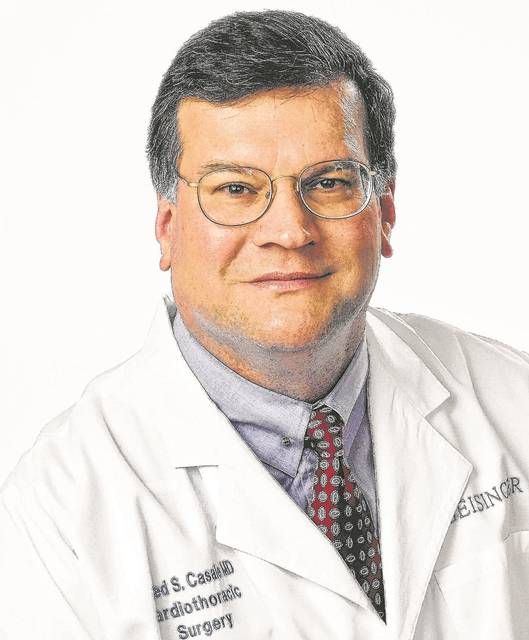Click here to subscribe today or Login.
Several months ago, we celebrated the christening of Eve, our newest granddaughter, at “Old St. Pat’s,” one of the only buildings that survived the Great Chicago Fire, and the parish Kate and Andy belonged to before they moved out of the city.
To make the logistics of the weekend easier, we all stayed at a lovely hotel off Michigan Avenue in downtown Chicago.
You’d think the beautiful ceremony, or the company of friends and relatives, or at least the party afterwards would have impressed big sister Rowan, but when asked, her first comment about the whole event is, “Doc sleeps loud.”
You see, as a treat for Rowan (but also for Mary and me), Rowan slept in our room with Mary, while I used the pull-out couch while Kate, Andy and Evie stayed next door. In all the rush of packing, I forgot the mask for my CPAP system, so I guess my snoring (I’m “Doc,” you see) impressed even a toddler!
It was one of very few nights over the last 25 years I’ve not used CPAP. Years ago, my otherwise tolerant wife, “encouraged” me to do something about my snoring and nightly episodes of interrupted breathing. After the studies and starting CPAP at nights, my life was SO much better … better rest, vivid dreams, healthier blood pressure and a much happier wife.
If you’ve struggled to get a good night’s sleep, too, you’re not alone. A recent survey from Consumer Reports found 164 million Americans have consistent issues with sleep, from trouble falling or staying asleep to disordered sleep from a medical condition.
Adults need to sleep between seven and nine hours each night to maintain good health. Sleep helps with weight control, reduces risk of heart problems, increases mental sharpness and boosts the immune system.
The first step to getting back on track is understanding the problem. Most people can trace sleep struggles to environmental factors, bad habits and stress. However, after an honest conversation with your doctor about these habits and health history, they may recommend a sleep study, or polysomnogram (PSG), to rule out any health problems.
Disorders like sleep apnea and restless legs syndrome can have a huge impact on your daily life. But they are treatable if you take the proper steps.
If your care team does decide to pursue a sleep study, here is what you need to know and what you can expect.
The sleep study
Sleep studies record your brain waves, blood oxygen levels, breathing, heart rate and eye movements during the night. Doctors will watch you cycle through the sleep stages to make sure you get non-rapid eye movement (NREM) and rapid eye movement (REM) sleep. Though both stages are necessary for a restorative sleep, REM sleep is where most dreaming takes place and when you have more brain activity.
On the day of the study, you should avoid alcohol or drinks with caffeine as they disrupt sleeping patterns. You will be able to bring any items needed for your nightly routine and can even bring your own pillow and pajamas.
Inside the sleep study room, you will be connected to monitors that allow specialists to keep an eye on your blood oxygen level, heart rate and brain waves throughout the night. There will also be a camera and radio system, so your team can monitor limb movements and speak to you.
In the morning, you wake up, leave and can go about your daily routine. Your doctor will schedule a follow-up appointment to assess the results.
Common sleep disorders
Of those 164 million Americans with trouble sleeping, nearly 70 million suffer from diagnosed sleep disorders. Some of the most common disorders are sleep apnea and restless legs syndrome.
• Sleep apnea is marked by a closing of your airway when sleeping, depriving your brain and body of oxygen. This can cause permanent damage over time. Symptoms include snoring, consistent sore throat or shortness of breath when waking, a lack of energy or consistent tired feeling.
Your doctor will diagnose sleep apnea if they notice irregular breathing during the sleep study.
It can be treated with continuous positive airway pressure therapy (CPAP), using a machine with a mask that applies mild air pressure, helping you maintain an even breathing pattern and keeping your airways open. Some patients have also found success with oral or dental devices to open the airway, or simply through changing their sleeping position.
• Restless legs syndrome (RLS) is marked by uncontrollable urges to move the legs and feet while resting. You may also involuntarily flex or extend limbs while sleeping. These movements will jerk you awake and interrupt the sleep stages, keeping you from feeling rested.
During the study, your doctor will monitor for these movements. If diagnosed, RLS can be treated with medication and lifestyle changes. Exercise in the afternoon or evening can make symptoms somewhat better so do tasks that require heavy concentration just before bed, like knitting or puzzles.
We’re going to see the kids on Cape Cod later this month. I’m sure a sleep-over with Rowan will be on the agenda. We’ll see what she thinks about the quieter sleeping “Doc” wearing his CPAP mask … I bet she’ll think I’m a jet pilot for dress-up!








